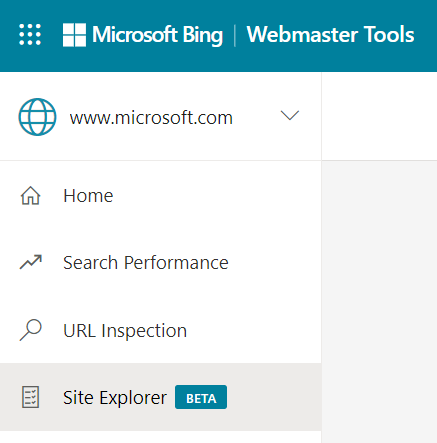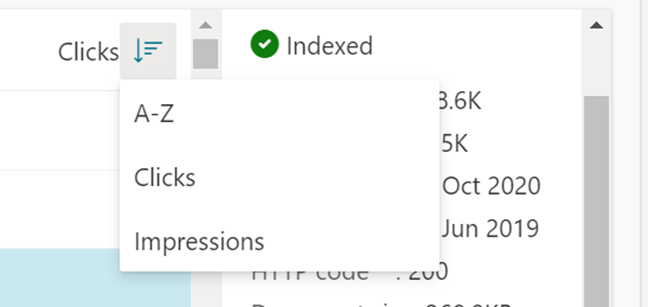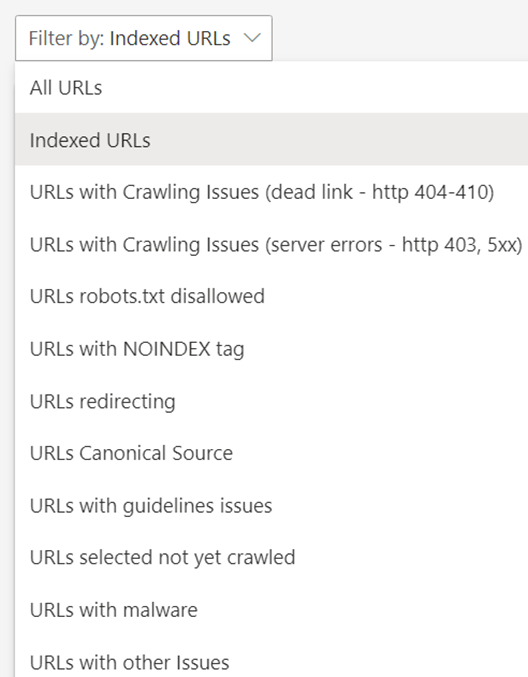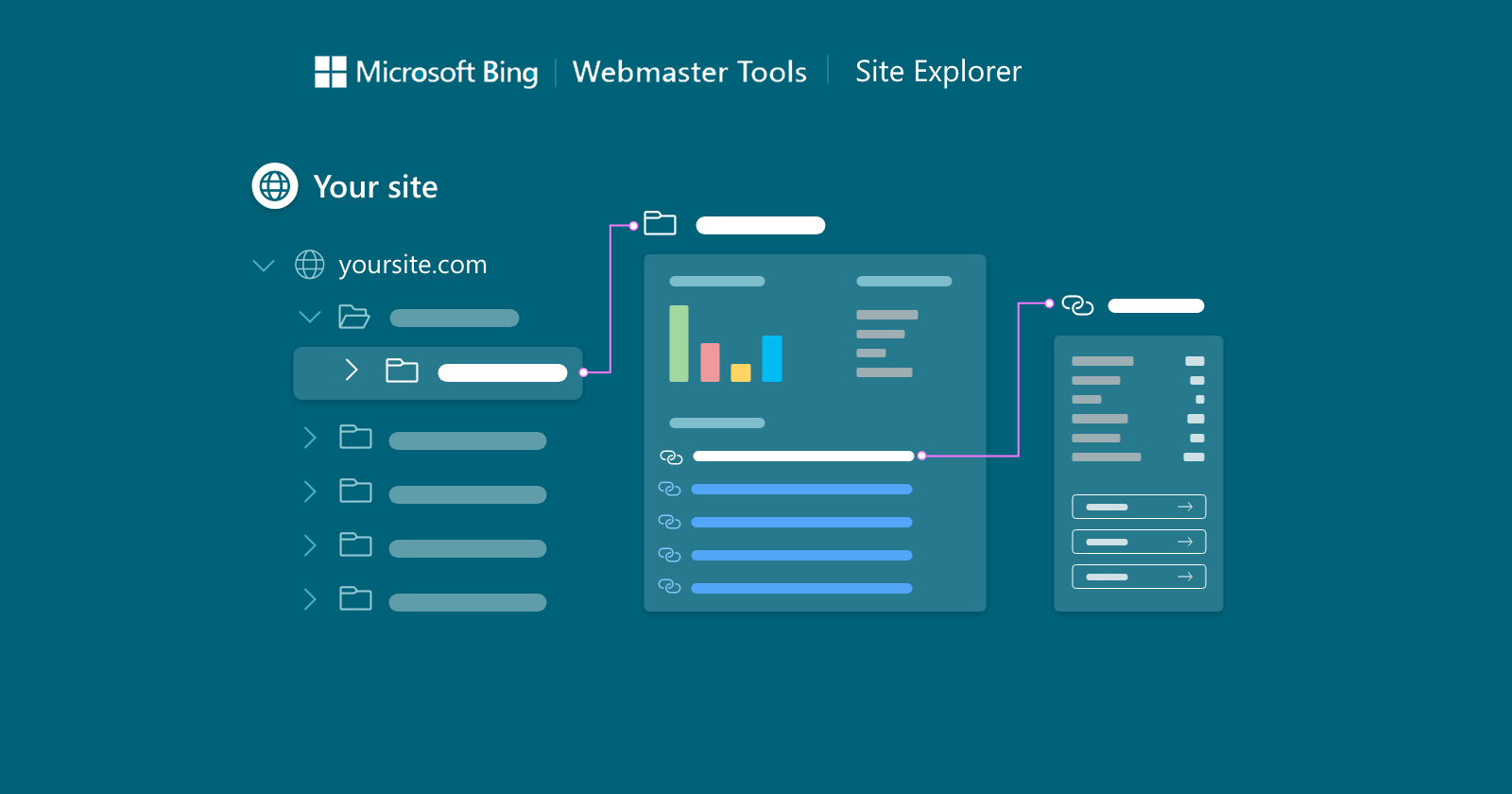Last month, the Microsoft Bing Webmaster Tools team released Site Explorer.
This new powerful SEO tool offers webmasters a unique view of how Microsoft Bing sees your site.
You can filter all your URLs in a file explorer-like fashion, including:
- Indexed URLs.
- URLs that are redirecting.
- URLs that are blocked by robots.txt.
This tool, which is not offered yet by other major engines, allows webmasters to explore and optimize their websites for all search engines.
From Index Explorer to Site Explorer
The previous version of Bing Webmaster Tools included a tool named Index Explorer which offered a subset of Site Explorer data and features.

However, Index Explorer had two flaws:
- As the tool was built by geeks for geeks, it became too complex for most SEO pros. There were many options and filters that did not help them understand and prioritize their SEO tasks.
- Slow and occasionally timed out for large web sites. When it was first developed many years ago, it was not meant to accommodate large websites with thousands of pages.
When we decided to refresh the Bing Webmaster Tools, we knew from listening to feedback and speaking with webmasters that significant investments were needed to improve Index Explorer.
We also had to deliver a useful SEO experience for webmasters.
Thus, the new Bing Webmaster Tools is based on key principles of:
- A cleaner and more responsive design.
- A faster portal with more actionable data.
Site Explorer’s Key Improvements
The new Site Explorer features these key improvements:
Access to All URLs Crawled & Indexed by Microsoft Bing
Site Explorer offers a view on the trillions of URLs discovered and the billions of URLs crawled daily by Microsoft Bing.
We no longer limit the number of URLs webmasters can see per site.
This means that for large web sites as facebook.com, webmasters can now access billions of URLs processed by Microsoft Bing.
Lightning Fast Even for Large Websites
We completely redesigned the backend datastore and web interface to keep Site Explorer lighting fast for any site even for extra-large websites as facebook.com.
You can load and explore your sites, your folders, your URLs , generally in less than one second, including for sites with millions of sub-domains, millions for URLs per folder.
Just keep scrolling to see more, you may exhaust your mouse battery or browser resources before getting to the end of extra-large folders.
Your whole site is instantaneously accessible in its entirety. Many webmasters of large sites and domains told us that this is the only way they have to navigate their whole site at such scale.
SEO Issues Are Easier to Find
The tool experience is now more user-friendly and intuitive for SEO.
Site Explorer has a responsive design, works well on mobile, and offers more filtering options which enable access to key SEO insights quickly and intuitively.
Site Explorer: An Overview

When you open Microsoft Bing Webmaster Tools, Site Explorer will appear as the fourth item in the navigation.

We believe Site Explorer will be a useful tool for the SEO community in exploring and optimizing websites – and the wide usage of this tool since its release confirms that.
When you open Site Explorer, by default, it instantaneously displays folders and URLs according to the number of clicks each received from Microsoft Bing search results over the past six months.
Site Explorer also gives webmasters options to sort folders and URLs:
- By impressions in Microsoft Bing search results.
- By alphabetical order.
Site Explorer gives you access to relevant crawl information per folder from the recent crawls of your site along with clicks, impressions, and backlinks counts.
Keep track of:
- Indexed URLs.
- URLs with crawl errors.
- URLs with warnings.
- Excluded URLs.

Webmasters can also:
- Inspect URLs for indexing issues and SEO analysis.
- Test any URL using the robots.txt tester tool.
The tool offers not only the ability to “SEO-explore” all URLs indexed but also filter URLs by type that webmasters should investigate, such as:
- URLs having crawling issues due to server errors.
- URLs not indexed to the redirect tag.
- URLs not indexed due to canonical tag source.
- URLs not following Microsoft Bing Webmaster Guidelines.
- Etc.

Thus, Site Explorer is a complete SEO solution for checking the SEO status and health of your sites and URLs.
Using Site Explorer to Optimize Your Site
Review & Optimize URLs Already Indexed
Remember that when you open Site Explorer, by default the tool lists folders and URLs already indexed starting from those with the most to the least clicks.
Are you expecting a specific number of clicks per folder and URL?
If you do, then consider enhancing your webpages to drive more benefits on your site.
If not, consider excluding these URLs from search engines or redirecting them when appropriate.
Are you getting a lot of impressions but a limited number of clicks?
If yes, then consider:
- Improving your title tags and meta descriptions.
- Writing meaningful content to get better search results and attract more clicks.
Are your URLs not getting enough clicks?
Inspect these pages via our URL Inspection tool.
Here, we provide SEO feedback on your URLs.
Also make sure to read the Microsoft Bing Webmaster Guidelines to better understand how Bing finds, indexes, and ranks websites.
Review URLs That Are Not Indexed & Index Them as Appropriate
Open Site Explorer and filter according to non-indexed URLs (i.e., URLs with the noindex tag or URLs with crawling issues).
Review whether these URLs should be indexed.
Use the Bing URL Inspection tool to find out each URL’s index status and markup information, including its live mode allowing you to test your changes without having to wait for the Bing crawler.
You’ll als0 see the URL’s crawling issues and SEO errors, if any.
Review All URLs
Open Site Explorer and filter by all URLs (first menu).
Do you really need that many URLs?
Less is more for SEO!
You might benefit by exposing less useless URLs to search engine crawlers and less duplicate content diluting the URLs and clicks.
Make sure you’re optimizing your content and avoiding duplication by consolidating pages when appropriate.
The Takeaway
We released the Site Explorer tool in Beta to collect feedback and improve it even more to help SEO professionals further explore and optimize your websites for search.
Please share your feedback on Twitter or LinkedIn.
More Resources:
- Bing Site Explorer Has Unique Tools for SEOs
- A Complete Guide to Bing Webmaster Tools
- How Search Engines Work
Image Credits
Featured & In-Post Images: Microsoft Bing




